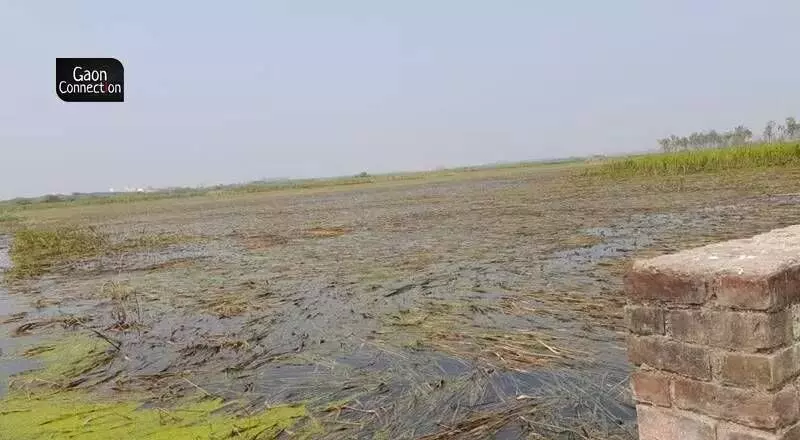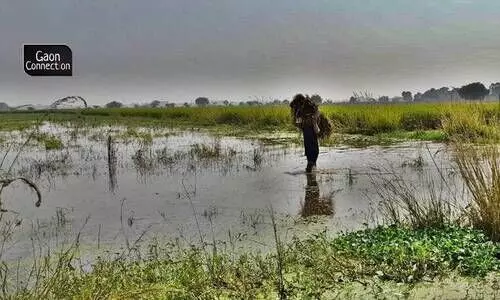Kanchan Kheda, Unnao (Uttar Pradesh)
The sight of his ready-to-harvest paddy lying flattened over the ten bighas [about 2.5 hectares] of land which he took on lease has devastated 28-year-old Srikrishna Rawat.
“I spent Rs 60,000 cultivating paddy over ten bighas. It wasn’t my land, I had acquired it on batayi [rent]. Since almost a month, the entire field has been submerged in stinking, polluted effluent. My entire crop is lost and the fertile land degraded,” Rawat, a resident of Kanchan Kheda village, complained to Gaon Connection.
Pointing towards an overflowing putrefying drain, which passes through Kanchan Kheda village, Rawat said: “I spent all my savings in the hope that I might get a good profit this year. I managed to protect my crop under drought conditions and pest attacks but this water leakage from the nullah [drain] has wreaked havoc on me and my family. Forget harvesting grains to feed my family, the spoiled paddy is not even worth feeding to my cattle.”
Also Read: Their farmland turned barren due to polluting effluent, villagers in UP’s Mirzapur to boycott polls
The 28-year-old farmer is amongst more than 1,000 farmers spread across 13 villages whose farmlands are inundated with dirty effluents from the drain, which is meant to carry treated effluents from the Common Effluent Treatment Plant (CETP) situated in the nearby Banthar village. The capacity of the plant is 1.5 million litres per day and its 40 kilometres-long drain ends at Ghassil Purwa village where it dumps the water into the Ganges.
Farmers in the Kanchan Kheda village allege that it has been too long since the drain from the CETP has been desilted which has led to it overflowing and submerging the agricultural fields along its flow.
Virendra Yadav, leader of the Pradhan Sangh (a group of village heads) informed Gaon Connection that the villages such as Kanchan Kheda, Raghunath Kheda, Pipar Kheda, Baliya Kheda, Dakri, Naya Kheda, Karmi, Bijlamau, Jaalimkheda, Baburiha, Jevakheda, Jojapur, and Supasi are reeling from the polluted water from the drain.

Many farmers in the area complained that if the problem of water leaking from the drain is not addressed immediately, the sowing of their next crop (rabi) will also be affected.
Also Read: ‘It is poison, not water, that comes out of the handpumps’
Similar to Rawat, 55-year-old Rajrani Devi is finding it hard to keep her disappointment to herself. When Gaon Connection visited the Kanchan Kheda village on November 6, Devi was found salvaging paddy crop from her effluent filled field in the hope of using it as fodder for her cattle.
“All my labour is wasted. I had somehow saved Rs 15,000 last year. I cut down on my expenses to raise that amount and invested it entirely on my dedh bighas [quarter of an hectare] of paddy crop. Now, my paddy is rotting in dirty water which entered our field about 15 days ago. I just hope I can salvage some of the crop to feed my cattle,” she said. According to her, the drain has been overflowing for about a month now.
‘Leaking drain making it impossible to prepare land for wheat’
Meanwhile, many farmers in the area complained that if the problem of water leaking from the drain is not addressed immediately, the sowing of their next crop (rabi) will also be affected.
“The time is ripe for the land to be prepared for planting wheat now. If the officials do not solve the problem immediately, we will be late for sowing wheat,” Bhagauti Rawat, a 60-year-old farmer from Raghunath Kheda village told Gaon Connection.
The farmer also pointed out that he had never witnessed so much effluent in his fields ever before.
“Basically, this entire problem is because the desilting of the drain hasn’t been done for a long time. The drains are getting narrower and the flow of effluent is heavy which is causing the water to leak out and enter our fields,” he alleged.
Also Read: 154 villages in Western Uttar Pradesh are drinking toxic water
Lack of desilting caused leak, efforts underway to desilt
When Gaon Connection contacted the officials at the government-run CETP and the state’s Irrigation and Water Resources Department to enquire about the reason behind the leaking drain, Bhagauti Rawat’s grievance was found to be apt.
“The drain in question is forty kilometres long. Last time its desilting was conducted was in 2020. Even though that desilting was done partially, its complete desilting could not be conducted as COVID-19 pandemic followed soon,” Shailendra Kumar, an Unnao-based executive engineer in the irrigation department, told Gaon Connection.
“We are aware that the waterlogging is being caused by the drain. We have made an estimate of the funds needed for a complete desilting of the drain and we have forwarded it to the higher authorities. Once its desilting is completely done, we hope that such a problem will not arise again,” the official added.
Also, the officials at the treatment plant blame the excess rainfall post-October which has increased the water levels in the drain.
“A total of 27 tanneries in the area send their effluent to our treatment plant. We treat it and the treated water is used for irrigating the fields in the area,” Rituraj Sahu, the general manager of the treatment plant, told Gaon Connection.
“It has rained too much since October which has increased the flow of the effluents. We are not releasing extra effluent, earlier in 2020, we used to daily release 1,200-1,300 kilolitres of treated effluent. Now we are releasing barely 1,100 kilolitres,” he added.




















